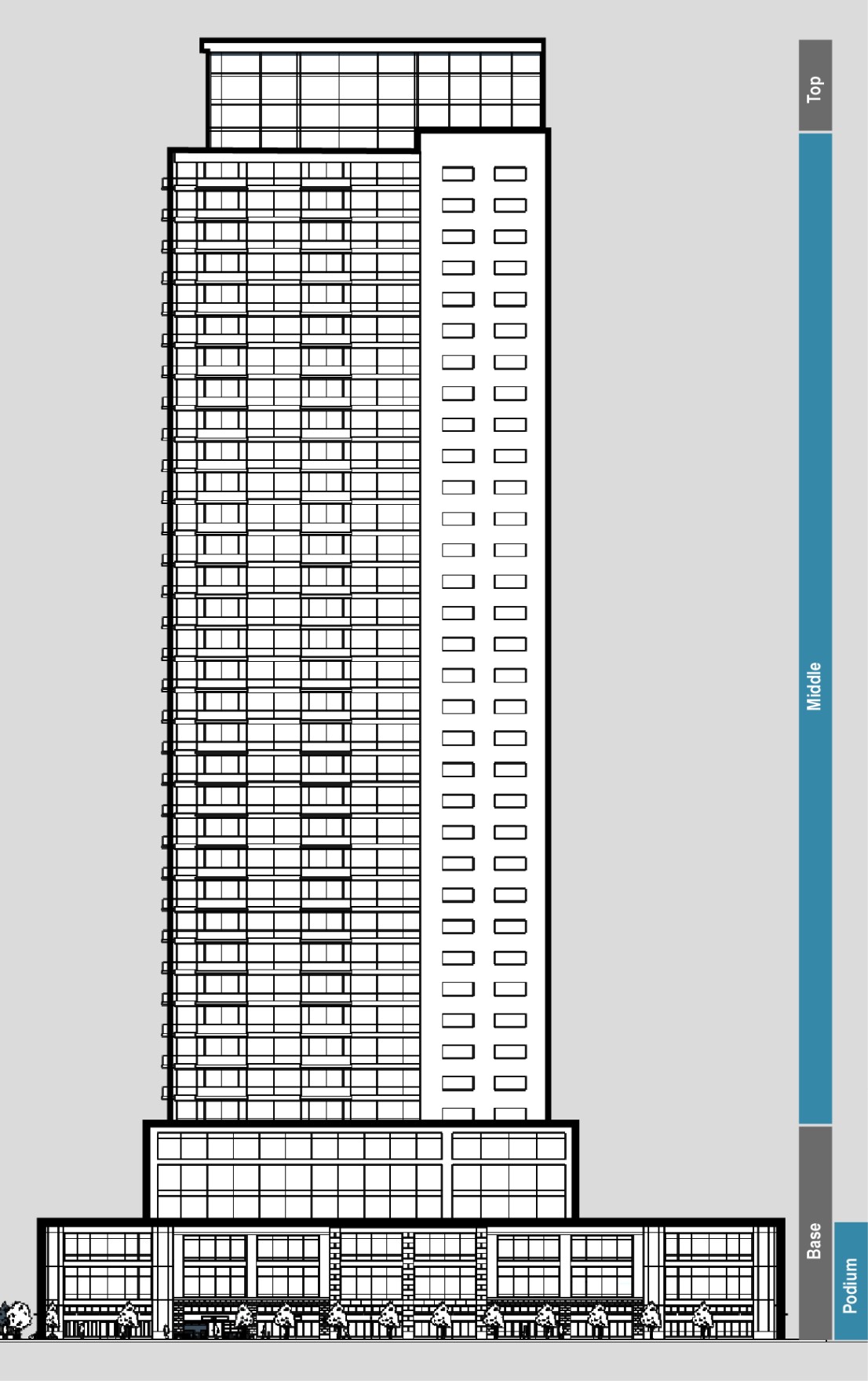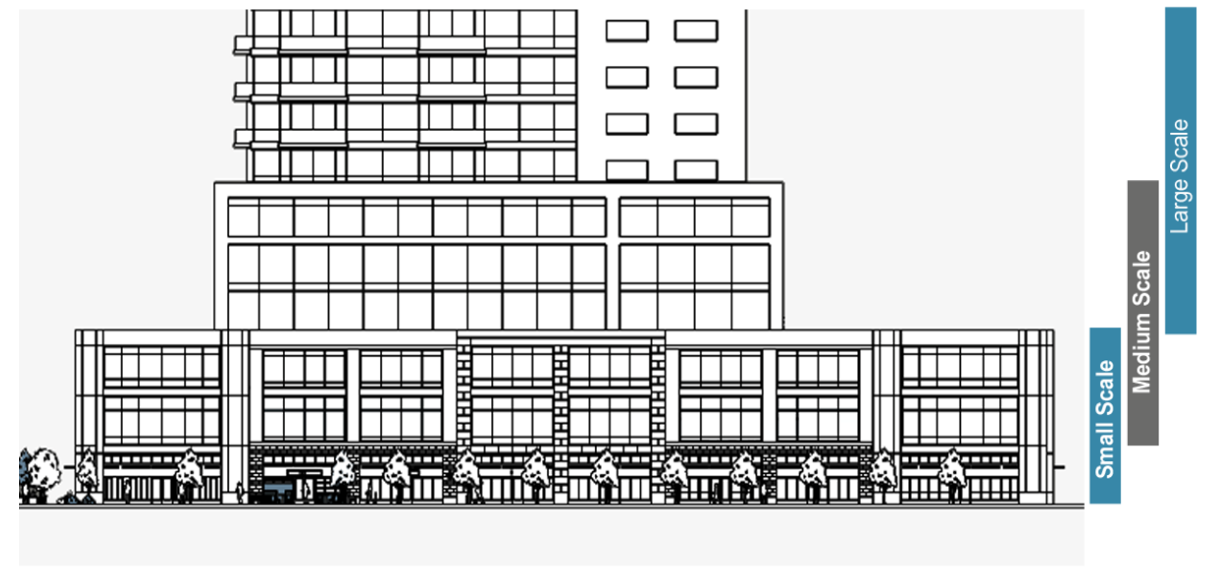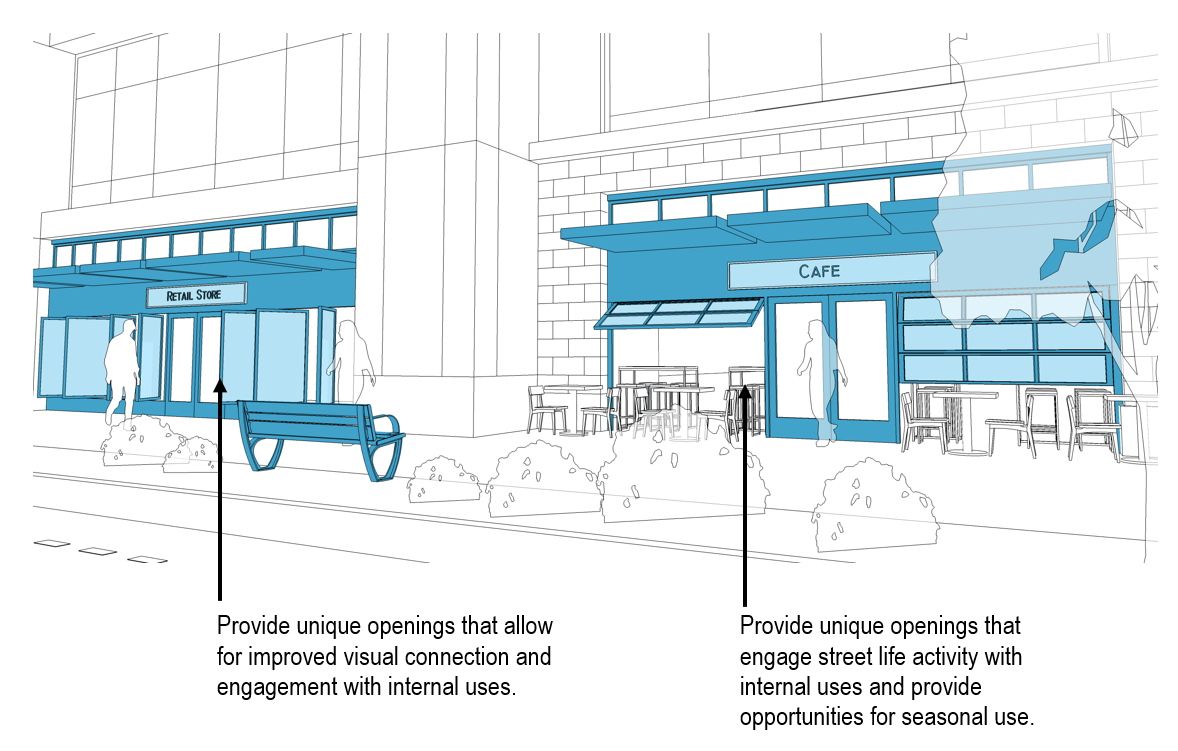20.25Q.160 Building design (base, middle, and top).
A. Introduction. A Building should consist of three carefully integrated parts: a Building base, middle, and top.
B. Overall Building Design.
1. Encourage High-Quality Materials.
a. Intent. Create a sense of permanence in East Main through the use of high-quality Building materials. Quality façade materials can provide a sense of permanence and bring life and warmth to a neighborhood. Façade and Building materials shall enhance the street environment while complementing the aesthetic quality of adjacent Buildings.
b. Guidelines.
i. Articulation of façade materials should be bold, with materials that demonstrate depth, quality, and durability;
ii. It should be apparent that the materials have substance and mass, and are not artificial, thin “stage sets” applied only to the Building’s surface;
iii. Use natural high-quality materials such as brick, finished concrete, stone, terra cotta, cement stucco, and wood in natural or subdued Building colors; and
iv. Use varied yet compatible cladding materials. Window and storefront trim should be well-defined and contribute to the overall aesthetic quality.

2. Provide Interesting Building Massing.
a. Intent. Use scale-defining articulation and other techniques to break up the longitudinal dimensions of Buildings, creating a comfortable sense of enclosure and human scale by establishing a dynamic, continuous street edge.
b. Guidelines.
i. The length and breadth of a Building should be Pedestrian-Scaled. Portions of a large Building mass should be broken into smaller, appropriately scaled modules, with changes in plane indicated by bold projections and recesses. This results in larger elevations being reduced to human scale;
ii. Vertical and horizontal elements should be used to create a human scale and form a coherent aesthetic providing visual interest to the pedestrian;
iii. Reduce the scale of elevations both horizontally and vertically;
iv. Buildings should exhibit a vertically articulated tripartite façade division – base, middle, and top through material and scale; and
v. Design should feature vertical articulation of windows, columns, and bays.

C. Mechanical Equipment Screening and Location Standards.
1. Applicability. The requirements of this section shall be imposed for all New Development, and construction or placement of new mechanical equipment on existing Buildings. Mechanical equipment shall be installed so as not to detract from the appearance of the Building or Development.
2. Location Requirements.
a. To the maximum extent reasonable and consistent with Building and Site design objectives, mechanical equipment shall be located in the Building, below Grade, or on the roof.
b. Where the equipment must be located on the roof, it shall be consolidated to the maximum extent reasonable rather than scattered.
c. Mechanical equipment shall not be located adjacent to a Sidewalk, pre-located street, Potential Street, Open Space, pedestrian and bicycle route, or other spaces designated open to the public.
3. Screening Requirements.
a. Exposed mechanical equipment shall be visually screened by a predominantly solid, nonreflective visual barrier that equals or exceeds the height of the mechanical equipment. The design and materials of the visual barrier or Structure shall be consistent with the following requirements:
i. Architectural features, such as parapets, screen walls, trellis systems, or mechanical penthouses shall be consistent with the design intent and finish materials of the main Building, and as high or higher than the equipment it screens.
ii. Vegetation or a combination of vegetation and view-obscuring fencing shall be of a type and size that provides a visual barrier at least as high as the equipment it screens and provides year-round interest, 50 percent screening at the time of planting, and a dense visual barrier within three years from the time of planting.
iii. Screening graphics may be used for at-grade utility boxes.
b. Mechanical equipment shall be screened from above by incorporating one of the following measures, in order of preference:
i. A solid nonreflective roof. The roof may incorporate nonreflective louvers, vents, or similar penetrations to provide necessary ventilation or exhaust of the equipment being screened;
ii. Painting of the equipment to match or approximate the color of the background against which the equipment is viewed; or
iii. Mechanical Equipment Installed on Existing Roofs. The Director may approve alternative screening measures not meeting the specific requirements of this section if the applicant demonstrates that the existing roof Structure cannot safely support the required screening; or the integrity of the existing roof will be so compromised by the required screening as to adversely affect any existing warranty on the performance of the roof.
4. Exhaust Control Standards.
a. Purpose. Where technically feasible, exhaust equipment shall be located so as not to discharge onto a Sidewalk, right-of-way, or area designated accessible to the public; including but not limited to the pre-located street, Potential Street, Open Space, pedestrian and bicycle route, and other spaces designated open to the public.
b. Exhaust Location Order of Preference. Mechanical exhaust equipment shall be located and discharged based on the following order of preference:
i. On the Building roof;
ii. On the service drive, alley, or other façade that does not abut a public street, Sidewalk or right-of-way;
iii. Located above a driveway or service drive to the property such as a parking garage or service court; or
iv. A location that abuts a public street or Easement; provided, that the exhaust discharge is not directly above an element that has earned FAR Amenity Incentive System points, such as a public Plaza.
c. If mechanical exhaust equipment is located as provided in subsection C.4.b.iii or iv of this section, then it shall be deflected from such public space and located at least 16 feet above Finished Grade, street, Easement or other area designated accessible to the public.
d. Exhaust outlets shall not be allowed to discharge to an area that has earned FAR Amenity Incentive System points, such as a public Plaza.
5. Modifications. The location and screening of mechanical equipment and exhaust systems are subject to review and approval at the time of Land Use review. The Director may approve an Administrative Departure pursuant to LUC 20.25Q.030.D.1 if the applicant demonstrates that the alternate location or screening measures provide an equal or better result than the requirements of this section.
6. Noise Requirements.
a. Mechanical equipment shall meet the requirements of Chapter 9.18 BCC, Noise Control.
b. The applicant shall be required to demonstrate the mechanical system compliance with the requirements of Chapter 9.18 BCC prior to issuance of a Certificate of Occupancy.
D. Building Base (Podium).
1. Introduction. The role of the Building base is to relate Buildings to the human scale and fit harmoniously within the existing or planned Street Wall context; define the edges of adjacent streets, parks, and Open Space in good proportion; and maintain access to sunlight for pedestrians, open and public spaces, and adjacent properties.
2. Upper Level Stepbacks.
a. Upper Level Stepback. Each Building façade located along the pre-located street as provided in LUC 20.25Q.100.C.2, Potential Street, and rights-of-way other than 112th Avenue SE shall incorporate a minimum 15-foot-deep Stepback at a height between 25 feet and the level of the first Floor Plate above 40 feet. This required Stepback may be modified if the applicant demonstrates through Design Review (Part 20.30F LUC) that:
i. The modification is necessary to achieve design elements or features encouraged in the design guidelines of LUC 20.25Q.130 through this section. Where a modification has been granted, the upper level Stepback may be incorporated between 25 feet and the level of the first Floor Plate above 45 feet.
3. Articulate the Building base with high-quality materials and design elements that fit with the aesthetic quality of neighboring Buildings and contribute to the Pedestrian Scale and experience.
a. Intent. The Building façade shall provide an architectural expression that relates to its surroundings and shall include materials and elements that can be viewed and appreciated at the speed, scale, and proximity of the pedestrians.
b. Guidelines.
i. Provide architectural expression and design elements such as cornice lines, window bays, entrances, canopies, Building materials, and fenestration, in a pattern, scale, and proportion that relate to neighboring Buildings and engage pedestrians;
ii. Use high quality, durable materials, an appropriate variety in texture, and carefully crafted details to achieve visual interest and longevity for the façade. Environmentally sustainable materials and construction methods are encouraged; and
iii. A Building’s profile should be compatible with the intended character of the area and enhance the streetscape. In some cases, it may be appropriate to mark an entryway with a distinct form to emphasize the significance of the Building entry.
4. Provide clear, unobstructed views into and out from Ground Floor Uses facing the Public Realm.
a. Intent. At street level, a series of unobstructed views into and out of Buildings enriches the urban experience for pedestrians and Building occupants. Transparency enhances visual interest, vitality, and increases safety for all.
b. Guidelines.
i. Transparent windows should be provided on façades facing streets, parks, and Open Spaces;
ii. Views into and out from Ground Floor Uses may not be obstructed by window coverings, internal furnishings, or walls; and
iii. Interior walls may be placed a minimum of 20 feet from the window on the façade where Ground Floor Uses are a requirement.
5. Design Inviting Retail and Commercial Entries.
a. Intent. Design retail and commercial entries to create an open atmosphere that draws customers inside while creating opportunities to engage the public.
b. Guidelines.
i. Primary entries to retail and commercial establishments should be transparent, allowing passersby to see the activity within the Building and bring life and vitality to the street;
ii. Architectural detail should be used to help emphasize the Building entry including canopies, materials, and depth;
iii. Building lighting should emphasize entrances;
iv. Provide transom, side lights, or other combinations of Transparency to create visual interest;
v. Provide double or multiple door entries; and
vi. Provide a diverse and engaging range of doors, openings, and entrances to the street such as pivoting, sliding or roll up overhead entrances.

6. Encourage Retail Corner Entries.
a. Intent. Use corner entries to reinforce intersections as important places for pedestrian interaction and activity.
b. Guidelines.
i. Locate entry doors on the corners of retail Buildings wherever possible. Entries at 45-degree angles and free of visual obstructions are encouraged;
ii. Locate primary Building entrance at the corner;
iii. Use Weather Protection, special paving, and lighting, to emphasize corner entry;
iv. Use architectural detailing with materials, colors, and finishes that emphasize the corner entry; and
v. Use doors with areas of Transparency and adjacent windows.
7. Encourage Inviting Ground Floor Uses and Commercial Windows.
a. Intent. Use Transparency to enhance visual interest and to draw people into retail and commercial uses.
b. Guidelines.
i. Retail and commercial uses should use unobstructed windows that add activity and variety at the street level, inviting pedestrians into retail and commercial uses and providing views both in and out;
ii. Use clear window glazing;
iii. Provide operable windows that open by pivoting, sliding or shuttering for restaurants, cafes, retail and commercial activity; and
iv. Install transom windows or other glazing combinations that promote visual interest.
8. Provide Multiple Entrances.
a. Intent. Multiple entrances break up monotonous façades, enhance visual interest, and enrich the pedestrian experience.
b. Guideline. Provide pedestrian entrances at frequent intervals to contribute to variety and intensity.
9. Integrate Building Lighting.
a. Intent. Architectural lighting that enhances and helps articulate Building design, including illumination of architectural features and entries, Points of Interest, uplighting and other effects.
b. Guidelines.
i. Exterior lighting of Buildings should be an integral component of the façade composition. Lighting should be used to create effects of shadow, relief, and outline that add visual interest and highlight aspects of the Building;
ii. Lighting should not cast Glare into residential units or onto adjacent Development or streets;
iii. Use accent lighting for architectural features;
iv. Provide pedestrian-oriented lighting features;
v. Integrate lighting within the landscape; and
vi. Provide dimmable exterior lighting.
E. Middle (Tower).
1. Tower Placement.
a. Intent. Tower placement can directly affect those on the ground plane by affecting wind conditions and the scale of the Building as compared to the pedestrian. Thoughtful Tower placement can minimize these effects.
b. Guidelines.
i. Place Towers away from parks, Open Space, and neighboring properties to reduce visual and physical impacts of the Tower and allow the base Building to be the primary defining element for the Site and adjacent Public Realm.
ii. Coordinate Tower placement with other Towers on the same block and adjacent blocks to maximize access to sunlight and sky view for surrounding streets, parks, Open Space, and properties.
2. Required Tower Separation. Tower Separation is intended to provide privacy, natural light and air, and contribute to a distinctive skyline.
a. Applicability. This subsection shall apply to multiple Towers within East Main built within a single Project Limit.
b. Separation. Two or more Towers built within a single Project Limit shall maintain a Tower Separation of 60 feet.
c. Modification With Criteria. Tower Separation may be reduced to a minimum of 20 feet between the closest points of multiple Towers measured 80 feet above average Finished Grade through an Administrative Departure pursuant to LUC 20.25Q.030 if the following criteria are met:
i. A maximum of 10 percent of the façade is within the Tower Separation distance of another Building’s façade; and
ii. The applicant demonstrates that the intrusion does not affect the light, air or privacy of the users of either Building.
3. Maximize energy efficiency in Tower orientation and articulation.
a. Intent. Tower orientation, articulation, and other features should be designed to respond to maximize solar orientation and to reduce mechanical heating and cooling.
b. Guidelines.
i. Orient Towers to improve Building energy performance, natural ventilation, and daylighting; provided, that access to sky view is maintained and adverse wind and shadow impacts are minimized;
ii. Vary the design and articulation of each Tower façade to respond to changes in solar orientation. Where appropriate, adjust internal layouts, glazing ratios, balcony placement, fenestration, and other aspects of the Tower design to manage passive solar gain and improve Building energy performance;
iii. Where possible, include operable windows to provide natural ventilation and help reduce mechanical heating and cooling requirements; and
iv. When multiple Towers are proposed, stagger the Tower heights to create visual interest within the skyline, mitigate wind, and improve access to sunlight and sky view. In general, a variation of five Stories or more provides a difference in height that can be perceived at street level.
4. Design Tower to provide visual interest and articulation.
a. Intent. Tower design should incorporate articulation, design excellence, and sustainable materials.
b. Guidelines.
i. Incorporate variation and articulation in the design of each Tower façade to provide visual interest and to respond to design opportunities and different conditions within the adjacent context; and
ii. Articulate Towers with high-quality, sustainable materials and finishes to promote design excellence, innovation, and Building longevity.
5. Promote Visually Interesting Upper Floor Residential Windows.
a. Intent. Upper floor residential windows should create an open and inviting atmosphere that adds visual interest and enhances the experience of the Building both inside and out.
b. Guidelines.
i. The windows of a residential Building should be pleasing and coherent. Their size and detailing should be of a human scale with regular spacing and a rhythm of similarly shaped windows; and
ii. Windows should be operable.
F. Top.
1. Create Attractive Building Silhouettes and Rooflines.
a. Intent. Building rooflines should enliven the pedestrian experience and provide visual interest with details that create dynamic and distinct forms.
b. Guidelines.
i. Building rooflines should be dynamic, fluid, and well-articulated to exhibit design excellence while creating a dynamic and attractive skyline;
ii. Include Towers or similar vertical architectural expressions of important Building functions such as entries;
iii. Vary roof line heights; and
iv. Incorporate well-detailed cornices that have significant proportions (height and depth) and create visual interest and shadow lines.
2. Foster Attractive Rooftops.
a. Intent. Integrate rooftop elements into the Building design.
b. Guidelines.
i. Roof shape, surface materials, colors, and penthouse functions should all be integrated into the overall Building design;
ii. Provide rooftop terraces, gardens, and Open Spaces;
iii. Incorporate green roofs that reduce Stormwater runoff;
iv. Consolidate and screen mechanical units; and
v. Occupied rooftop amenity areas are encouraged; provided, that potential noise and light impacts on neighboring Developments are minimized. (Ord. 6627, 12-13-21, § 3)